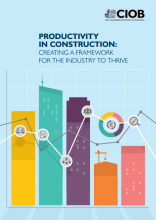Productivity in construction: Creating a framework for the industry to thrive
On 24 May 2016, the Chartered Institute of Building (CIOB) published a report intended to inspire debate about productivity in the UK construction industry, and how the built environment supports productivity growth in the UK as a whole.
Government figures released in April 2016, demonstrated the biggest fall in UK productivity since the financial crisis in 2008. In construction, productivity has only improved by 1.4% since 1997.
The new report, Productivity in Construction: Creating a Framework for the Industry to Thrive, uses the Government’s 15-point productivity plan as a framework, illustrating how, point-by-point, construction acts as an agent of change to improve productivity within the wider economy, how it might improve its own internal productivity, as well as highlighting the opportunities and challenges in delivering improvement.
Most advanced nations demonstrate poor productivity growth in construction and have done for many years. That this is a global issue suggests that difficulties in improving productivity are likely to be within the nature of the industry rather than specifically within the UK. The factors that can boost productivity are well known, at least in theory, and have been for many decades. This suggests the problems holding back progress lie deep within the industry.
The report seeks to identify what these factors might be, supported by survey evidence from across the industry, policy makers and industry experts showing a wide consensus on many of the policies that should boost construction productivity.
Construction analyst and report author Brian Green further explains why caution is needed in interpreting the bald statistics:
“Firstly, there’s a need to measure more effectively the productivity of the whole process of delivering the built environment, rather than just what happens on site. Otherwise we end up missing the beneficial impacts of, for instance, better design or off-site manufacture.
“Secondly, we need to look at what construction does rather than what it is and how it impacts on the wider economy. And, thirdly, it is worth noting that as nations develop they often choose to spend more on repairing, maintaining and adapting the existing built environment. This work tends to be more labour intensive than new work, so can have the effect of suppressing the overall labour productivity figures.
“Paradoxically, you could be building more productively to a higher quality, with innovation in design, product manufacture and construction management, while the statistics suggests the industry is becoming less productive.”
“As the OECD states, productivity is about working smarter, rather than working harder.”
While the report makes a number of practical recommendations from its findings - such as tying public investment to training and job creation; developing new business models and financial models with incentives directed more towards productivity; and creating construction innovation and excellence hubs - it expresses two more fundamental concerns:
- Firstly, productivity may be being measured incorrectly. The value of the design, the materials and components, and much of the plant and machinery used on site are not counted, and it’s difficult to measure improvements in quality or safety.
- Secondly, and perhaps most importantly, it stresses that as the quality of the output construction produces generally boosts the productivity of the rest of the economy, productivity in construction should not be seen as an end in itself.
CIOB conclude, 'while construction productivity must improve, it must improve in such a way that enhances the productivity of the whole nation. Any understanding of this should be at the heart of policy making.'
To read the research see Click here.
--CIOB
[edit] Related articles on Designing Buildings Wiki
- Benchmarking.
- Construction productivity 1977.
- Demonstration project.
- Earned value.
- Identifying the causes of trends in construction labour productivity.
- Increasing productivity in 2018.
- Key Performance Indicators.
- Productivity.
- Tackling the productivity challenge.
- The history of human resource management.
Featured articles and news
RTPI leader to become new CIOB Chief Executive Officer
Dr Victoria Hills MRTPI, FICE to take over after Caroline Gumble’s departure.
Social and affordable housing, a long term plan for delivery
The “Delivering a Decade of Renewal for Social and Affordable Housing” strategy sets out future path.
A change to adoptive architecture
Effects of global weather warming on architectural detailing, material choice and human interaction.
The proposed publicly owned and backed subsidiary of Homes England, to facilitate new homes.
How big is the problem and what can we do to mitigate the effects?
Overheating guidance and tools for building designers
A number of cool guides to help with the heat.
The UK's Modern Industrial Strategy: A 10 year plan
Previous consultation criticism, current key elements and general support with some persisting reservations.
Building Safety Regulator reforms
New roles, new staff and a new fast track service pave the way for a single construction regulator.
Architectural Technologist CPDs and Communications
CIAT CPD… and how you can do it!
Cooling centres and cool spaces
Managing extreme heat in cities by directing the public to places for heat stress relief and water sources.
Winter gardens: A brief history and warm variations
Extending the season with glass in different forms and terms.
Restoring Great Yarmouth's Winter Gardens
Transforming one of the least sustainable constructions imaginable.
Construction Skills Mission Board launch sector drive
Newly formed government and industry collaboration set strategy for recruiting an additional 100,000 construction workers a year.
New Architects Code comes into effect in September 2025
ARB Architects Code of Conduct and Practice available with ongoing consultation regarding guidance.
Welsh Skills Body (Medr) launches ambitious plan
The new skills body brings together funding and regulation of tertiary education and research for the devolved nation.
Paul Gandy FCIOB announced as next CIOB President
Former Tilbury Douglas CEO takes helm.
UK Infrastructure: A 10 Year Strategy. In brief with reactions
With the National Infrastructure and Service Transformation Authority (NISTA).
























